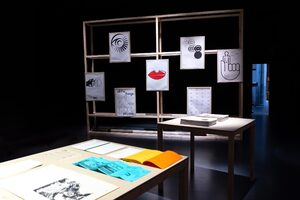Daniel Irrgang
| Name | Daniel Irrgang |
2 Inhalte
- Seite 1 von 1
all the things you are.
- Titel
- all the things you are.
- Untertitel
- Die Lebenszeichen von Wolfgang Schmidt
- Untertitel des Projekts/Werks (en)
- Signs of life from Wolfgang Schmidt
- Autor/in
- Beschreibung (de)
- Der Künstler und Grafiker Wolfgang Schmidt (* 24. Juli 1929; † 8. März 1995) begann 1972 mit der Gestaltung seines individuellen Zeichensystems: Den Lebenszeichen. Bis 1979 waren von den geplanten 893 Zeichen 262 fertiggestellt, in Kombination miteinander ergeben sich aus ihnen über 394 Variationen. [...] Die Ausstellung "all the things you are." geht diesem Katalog nach und zeigt neben originalen Drucken, auch eine Auswahl an Manuskripten und Plänen. [...] Die Exponate in der Ausstellung werden durch neu entstandene Arbeiten ergänzt, welche die durch Schmidts Zeichensystem aufgeworfenen Fragen nach Identität, Emotion und Kommunikation aufgreifen.
- Beschreibung (en)
- The artist and graphic designer Wolfgang Schmidt (* July 24, 1929; † March 8, 1995) began designing his individual sign system in 1972: the signs of life. By 1979, 262 of the planned 893 signs had been completed; in combination with each other, they resulted in over 394 variations. [...] The exhibition "all the things you are." explores this catalog and shows original prints as well as a selection of manuscripts and plans. [...] The exhibits in the exhibition are supplemented by newly created works that address the questions of identity, emotion and communication raised by Schmidt's system of signs.
- Kategorie
- Typ des Projekts/Werks
- Schlagworte
- Mitwirkende
- Ort: Institution
- Ort
- Großes Studio
- Stadt
- Land
- Bemerkungen
- Digitalisierung der Lebenszeichen:
Massimiliano Audretsch, Jona Dienst, Rana Karan & Alper Kazokoglu, Victoria Langmann, Yannick Nuss, Felix Plachtzik, Bernadeta Rimutyte
Gestaltung der Lebenszeichen Hoodies:
Janina Capelle und Hanna Scherwinski
Leihgaben: Anke Schabacker, Inez Franksen, INTeF Darmstadt
Sponsoring und Unterstützung:
Stiftung Landesbank Baden-Württemberg
Kulturbüro Karlsruhe
AStA der Staatlichen Hochschule für Gestaltung Karlsruhe
Badischer Kunstverein
DUSS Maschinenfabrik
Leitner Ausstellungssysteme
- Digitalisierung der Lebenszeichen:
- Titel
- all the things you are.
- Projektleiter/in
- Semester
- Studiengang
- Typ der Abschlussarbeit
- Importiert am
- 14.06.2024
- Übergeordnete Sets
- 2
- Set enthält
- 0 6
Critical Zones: An open laboratory exhibition at HfG
- Titel
- Critical Zones: An open laboratory exhibition at HfG
- Autor/in
- Beschreibung (en)
- “Critical Zones”: Developing concepts and approaches for grasping the New Climatic Regime (Bruno Latour), that is the transformations in the relations of humans to their “terrestrial” conditions of existence. – The seminar series of Bruno Latour at HfG analyses these transformations as epistemic breaks and shifts of knowledge by drawing an analogy to the scientific revolution in the 17th century, where, after a crisis of former sound knowledge, new epistemic systems, representations and narrations in art, science, and religion had to be constructed and reintegrated into new dispositifs of knowledge. The project tackles an important aesthetic question, which overpasses simple forms of illustration of knowledge: How central is the imaginary capacity of the arts in constructing representations and narrations that are depictions and “generators” of new knowledge systems and therefore vital means of cultural change?
The exhibition at HfG in November will display some preliminary results of the projects developed by the seminar participants. It presents an opportunity to discuss – in a mode of work-in-progress – research questions, aesthetic approaches and epistemic experiments with colleagues and students of HfG and ZKM.
Opening: Nov 7, 19:00; duration: Nov 8, 10:00-19:00, Nov 9, 10:00-15:00
HfG, mittlere Lichtbrücke
- “Critical Zones”: Developing concepts and approaches for grasping the New Climatic Regime (Bruno Latour), that is the transformations in the relations of humans to their “terrestrial” conditions of existence. – The seminar series of Bruno Latour at HfG analyses these transformations as epistemic breaks and shifts of knowledge by drawing an analogy to the scientific revolution in the 17th century, where, after a crisis of former sound knowledge, new epistemic systems, representations and narrations in art, science, and religion had to be constructed and reintegrated into new dispositifs of knowledge. The project tackles an important aesthetic question, which overpasses simple forms of illustration of knowledge: How central is the imaginary capacity of the arts in constructing representations and narrations that are depictions and “generators” of new knowledge systems and therefore vital means of cultural change?
- Typ des Projekts/Werks
- Schlagworte
- Datierung
- 07.11.2018 - 09.11.2018
- Mitwirkende
- Ort
- Hochschule für Gestaltung Karlsruhe
- Stadt
- Land
- Beteiligte Institution(en)
- Titel
- Critical Zones: An open laboratory exhibition at HfG
- Projektleiter/in
- Semester
- Importiert am
- 17.01.2019
- Übergeordnete Sets
- 1
- Set enthält
- 0 8

